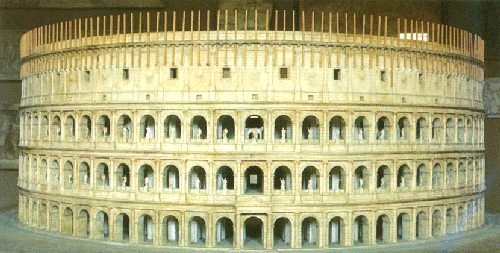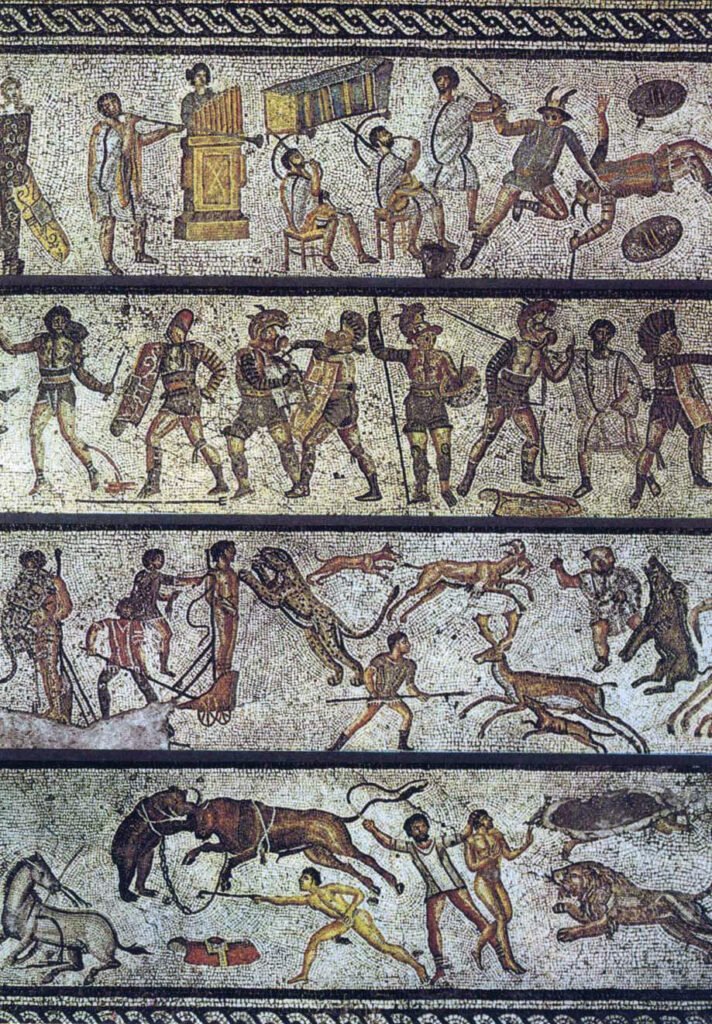
The inauguration
of the Roman amphitheatre must have been an unforgettable event. The historian Dio Cassius wrote, about it: “Most of what he [Titus] did was not characterized by anything noteworthy, but in dedicating the hunting-theatre (Amphitheatrum Flavium) and the baths that bear his name, he produced many remarkable spectacles. There was a battle between cranes and also between four elephants; animals both tame and wild were slain to the number of nine thousand; and women (not those of prominence however) took part in dispatching them. As for the men, several fought in single combat and several groups contended together both in infantry and naval battles. For Titus suddenly filled this same theatre with water and brought in horses and bulls and some other domesticated animals that had been taught to behave in the liquid element just as on land. He also brought in people in ships, who engaged in a sea-fight there, impersonating the Corcyreans and Corinthians….
These were the spectaculars that were offered and they continued for a hundred days; but Titus also furnished some things that were of practical use to the people. He would throw down into the theatre from aloft little wooden balls variously inscribed, one designating some article of food, another clothing, another a silver vessel, or perhaps a gold one, or again horses, pack animals, cattle or slaves. Those who seized them were to carry them to the dispensers of the bounty, from whom they would receive the article named“. [Dio Cassius. 65.25].

It had taken about ten years to build the amphitheatre. it is generally accepted by the scholars that Vespasian started the works in 72 AD, that his son Titus dedicated it in the year 80 with magnificent games that lasted one hundred days, and that it was completed by the following emperor, Domitian, Titus’ brother.
It is interesting to investigate: where did the idea of the completion of the amphitheatre by Domitian came from? It all started with a source of the IV century, the so-called Chronographus. In the Chronica Urbis Romae, written in 354, there is a list of the kings of Latium, the history of the Republic of Rome, that of Julius Caesar and that of the Emperors, down to Licinius. The information on the emperors aren’t many, but the Flavians are mentioned because of their building activity. It has been recognized that Suetonius is the source of the Chronoghraphus for the most ancient history, but we do not know the original source of the imperial biographies.
In any case, Chronographus writes: Hic (Vespasianus) prior tribus gradibus amphiteatrum dedicavit. That means that Vespasian dedicated (we would say inaugurated) the amphitheatre with the first three floors.
And then: Hic (Titus) amphitheatro a tribus gradibus patris sui duos adiecit.
In other words, Titus added two more floors to the three ones built by his father.
And again: Domitianus imperavit annos XVII, menses V. dies V. Hoc imperante multae operae publicae fabricatae sunt; atria VII, horrea piperataria, ubi modo est basilica Constantiniana et horrea Vespasiani, templum Castorum et Minervae, portam Capenam, gentem Flaviam, Divorum, Iseum et Serapeum, Minervam Chalcidicam, Odeum, Minuciam veterem, Stadium, et thermas Titianas et Traianas, Amphiteatrum usque ad clypea, templum Vespasiani et Titi, Capitolium, Senatum, ludos IIII, Palatium, Metam Sudantem et Panteum.

So, according to the Chronographus the building of the Colosseum seems well split among the three Flavian emperors; almost too nice to be true. In my modest opinion, the story of the three emperors sounds to me like a metropolitan legend of the antiquity, a tradition of the Roman people distorted after generations (in any case, after 50 years there is no one to confute it), like the stories of ghosts, demon-possessed statues and haunted houses that my Roman grandmother used to tell me. When I inquired about her sources she used to say: “Oh, it’s always been known to be like that”.
Let us go back to Suetonius: he writes that Vespasian was the one to build the amphitheatre, among the rest: Vesp. XI,1,:
Fecit et nova opera templum Pacis Foro proximum Divique Claudi in Caelio monte coeptum quidem ab Agrippina, sed a Nerone prope funditus desctructum; item amphitheatrum urbe media, ut destinasse comperat Augustum.
and states that Titus inaugurated it:
Tit., VII,3 … amphitheatro dedicato thermisque tuxta celeriter exstructis munus edidit apparatissimum largissimunque; dedit et navale proelium in veteri naumachia, ibidem et gladiatores atque uno die quinque milia omne genus ferarum.
He says that Domitian was the editor of lavish shows:
Dom., IV,1: Spectacula assidue magnifica et sumptuosa edidit non in amphitheatro modo, verum et in circo, ubi … ; at in amphitheatro navale quoque. And then… Edidit navalis pugnas paene iustarum classium, … and again, builder of forums and naumachiae: Novam autem excitavit aedem in Capitolo Custodi Iovi et forum quod nunc Nervae vocatur, item Flaviae templum gentis et stadium et odium et naumachiam, e cuius postea lapide maximus circus deustis utrimque lateribus extructus est.

In the end, if we compare the lists of Chronographus with the ones of Suetonius and Dio Cassius (who by the way complicates things by mentioning naumachiae, words interpreted by many as referred to the Colosseum), some scholars (e.g. Rossella Rea, in Anfiteatro Flavio, Quasar) seem to doubt about the story of the three emperors. It seems that for centuries the Chronographus misled the scholars, who, as an example, have for a long time attributed to Domitian the Baths of Titus (as plainly declared by the stamps on the bricks).
And then, there are the “Acta” of the Fratres Arvali. As everybody knows, this inscription registers that in the year 80 the Arvales had their seats assigned in the various orders of the amphitheatre, even in the maenianum summum in ligneis. How could they have seats assigned when the maenianum had not been already built?

What is sure is that the Chronographus has deceived great minds (I am not going to cite them) who have made any effort to explain:
- that the coins made in AD 80 – in which the amphitheatre looks complete – had been minted for sheer propaganda reasons,
- that the division of seats of the Arvali was pre-emptive,
- that they forced (here I cite R. Rea) an adaptation of the sources contemporary to the completion of the amphitheatre, so as to match what was stated by the Chronographus, who wrote 250 years later.
